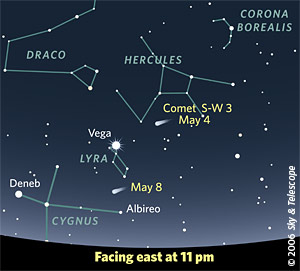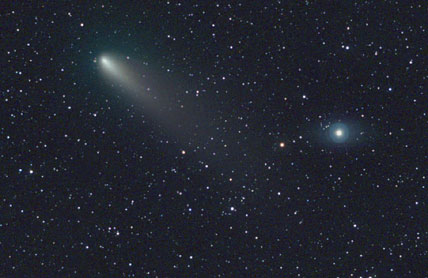
The brightest piece of Comet Schwassmann-Wachmann 3 (Fragment C) is passing from Hercules into Lyra. Its position is plotted here for late evening on May 4th and 8th (local dates for North America). Interpolate between them for the nights of May 5, 6, and 7. The comet will not appear nearly as bright as shown; you'll need binoculars and a fairly dark sky. See our article for details and for charts showing where to look for Fragment B, which is nearly as bright.
Sky & Telescope diagram.
Amateur astronomers everywhere have been following the double comet Schwassmann-
Wachmann 3, which is currently well up in the east in late evening. Its two largest pieces are currently 7th or 8th magnitude — not as bright as was hoped (Sky & Telescope, May issue, page 60), but still visible with good binoculars through a not-too-badly light-polluted sky. There have even been a few reports of naked-eye sightings under very dark skies. See our updated article for the whole story and for links to more detailed charts.

The comet crossing the familiar constellation Lyra. Double dates are the local dates for midnight in North America. Starting May 11 (on the large chart that you get by clicking the image above), dates are for the early morning hours.
Sky & Telescope diagram.
A special event happens this Sunday night, May 7th. The comet's brightest piece, Fragment C, will cross the Ring Nebula in Lyra! The comet will appear brighter and much larger than the Ring, which is 9th magnitude and only 1 arcminute wide.
Closest approach should be around 11 p.m. Eastern Daylight Time (3:00 May 8th Universal Time). This timing is best for observers on the eastern side of the continent.
Get out your telescope for this one. And if you're set up to take pictures through your scope, you could get quite a souvenir. We'll surely see pictures of this pairing in books and magazines for years to come. Take one of your own!

Fragment C displays a classic pale, aquamarine-gray-green gas coma, along with a redder dust tail, in this CCD image taken by Sky & Telescope's Sean Walker on the morning of April 29. This frame is about 80 arcminutes wide.
S&T; Sean Walker.
 0
0
Comments
You must be logged in to post a comment.